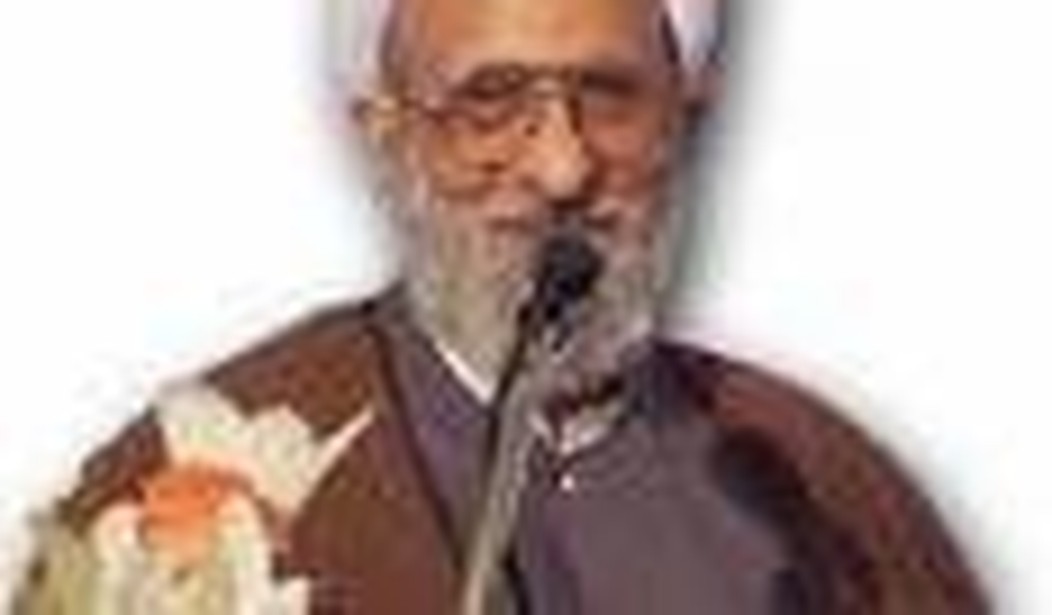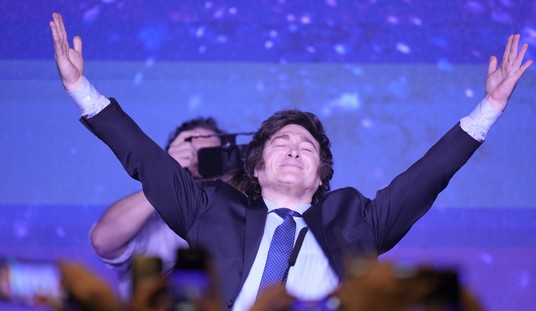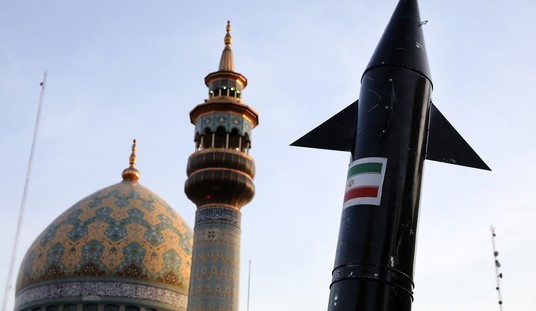Amir Taheri brilliantly describes the present Iranian government: “Usually portrayed as a theocracy, the Islamic Republic is, in fact, a form of oriental despotism with a turban.”
One of the most powerful figures in this despotism, and one of the least known in the West, is the hardline Ayatollah Mohammad Taghi Messbah-Yazdi, Mahmoud Ahmadinejad’s spiritual advisor. To understand the power and influence of Messbah-Yazdi, one needs to learn a bit about the Hojjatieh sect of Shi’ite Islam. The Hojjatiyeh movement was founded in the early ’50s by Mahmoud Halabi, a cleric of Arab ancestry and Iranian nationality. The movement believes in the imminent return of the Hidden Imam, Mehdi (a.k.a The Mahdi, the 12th Imam or Sawheb’o’zaman, which means the lord and master of all time). The Mahdi is the 12th descendant of the prophet Mohammad, whose reappearance is predicted for a time when the Muslims are suffering from disaster and injustice; true Islamic rule is possible only upon his return.
The Hojjatiyeh movement opposes the Shi’ite version of a Caliphate, the Velawyat’eh Fagheeh (which Amir Taheri translates as The Regency of the Theologians), which was a principle articulated by Khomeini. Therefore, in a July 1983 speech, Khomeini outlawed the movement and ordered the arrest of Hojjatiyeh supporters. Some he even ordered executed.
Contrary to the concept of Velawyat’eh Fagheeh, which states that all political power should be in the hands of a single leader, Hojjatiyeh claims that a collective leadership should rule until the Imam’s return. The movement’s economic views are liberal, which is the why it enjoys the support of traditional bazaar merchants and landowners; they object to any religiously-based official supervision.
Hojjatiyeh actively encourages its members to spread chaos and violence in society and the world at large, in order to hasten the return of the Twelfth Imam. The movement made the headlines on April 24, 1999, when its members attempted to assassinate the head of Tehran’s judicial system, Ali Razini. In late 2002 and early 2003 Hojjatiyeh increased its activity. In response, Iranian senior officials quickly issued a warning against the entrance of its members into government institutions.
One of the primary missions behind the creation of the sect was the annihilation of the Baha’i faith. The Hojjatieh vigilantes have targeted Baha’i places of worship, gatherings and cemeteries (click here to see Ahmadinejad’s comments on the Baha’is at the U.N. press conference in September).
Shi’ites generally regard Baha’ism as a heresy: according to Shiite theology, the Hidden Imam went into hiding when he was a child, and they believe he will reappear when the world is being destroyed by oppression and tyranny. Baha’is, on the other hand, believe that Mirza Hossein Ali, known as Baha’ollah, was the reincarnation of the Hidden Imam and that he has already appeared and established Baha’ism. The members of Hojjatieh view this idea as blasphemy, for they believe that Mehdi’s reappearance will usher in the end of the world as we know it, and thus the Baha’is are blasphemously following a false Mehdi.
Ahmadinejad belongs to the Jamkaran group. This is a subdivision of the Hojjatiyeh, named after the Jamkaran mosque, which is located on the outskirts of Qom. The Jamkaran Mosque is a sacred site for the disciples of the Mahdi, who according to a local tradition, drew the plans for the mosque himself and gave them to a man in a dream. Until recently the mosque’s link to the Hidden Imam remained a purely local myth, with little backing from the clergy. But one of the first administrative acts of the newly elected president was to allocate $20 million worth of funding from the government’s coffers to the Jamkaran mosque, in order to strengthen the cult of the Mahdi by creating a place to draw the pilgrims.
MESSBAH-YAZDI
The Ayatollah Messbah-Yazdi is a man of many contradictions. He is totally against both “taqqiyah” (obfuscation) and “kitman” (dissimulation), Shi’ite doctrines which the ruling Mullahs have been perfected into an art form over the centuries, and certainly over the last 30 years. Messbah-Yazdi, however, directly and openly says what other Mullahs only think or discuss amongst themselves only in Farsi, making sure that no English translation of their discussions ever reaches Western ears.
Messbah-Yazdi believes in total isolation from the West. He also has a message for those who deviate from his fundamentalist interpretations of Qur’anic texts: “If someone tells you he has a new interpretation of Islam, sock him in the mouth.” He wholeheartedly supports the fatwa against the author Salman Rushdie, and is suspected of giving religious sanction to the regime’s envoy assassins, who were sent to murder political opponents both inside and outside Iran throughout the ’90’s.
He is also a proponent of slavery, the death penalty and public floggings, and other forms of torture and punishment (i.e. stoning to death, cutting hands and plucking out eyes), as well as the use of suicide bombers against those he considers the “enemies of Islam.” In fact, Messbah-Yazdi has not only always been very well aware of the barbarous tortures practiced on prisoners in the Evin Prison, he has actively endorsed and justified them from a religious standpoint. Assadollah Lajevardi, the cleric known as the Butcher of Evin prison, is one of the most prominent members of the Islamic Motalefeh Group, and is a very close friend and associate of Messbah-Yazdi.
Messbah-Yazdi’s Persian-language weekly, Parto Sokhan, regularly prints recruitment advertising asking for volunteers for “martyrdom-seeking missions.” These were originally to be directed against the American forces in Iraq or the “Jews in occupied Palestine,” but now their sphere has expanded, and includes Europe, Asian and Arab countries, and generally anyone who stands in the way of the laying of the foundation for the reappearance of the Mahdi. After the disastrous tsunami in Asia, the journal wrote: “(the disaster) was indubitably the expression of God’s wrath, because those beaches that have been destroyed had been turned into centers of corruption and prostitution; the tsunami killed more than 7,000 sex tourists from the West.” A devoted student of Messbah-Yazdi, Mohsen Ghorourian, a veritable echo of his mentor, asserts that using nuclear weapons has religious legitimacy.
In 2001, the most progressive of the so-called “reformist” newspapers, Khordad Daily (which was one of the first in a series of publications that the regime’s judiciary banned), splashed across its front page in large type a quote from Messbah-Yazdi: “If anyone insults the (Islamic) sanctities, Islam has permitted for his blood to be spilled, and no need for a trial either.”
The ayatollah’s vehement opposition to Iranians being exposed to new ideas and concepts that challenge Islamic dogma is the impetus for Ahmadinejad’s censorship, which reaches far and wide — leading to, for example, a ban on foreign films which was issued in October 2005. There is no free inquiry. As far as Messbah-Yazdi is concerned, allowing people to read and interpret the Qur’an for themselves, let alone exercise anything that smacks of independent thought, is out of the question. In a recent interview, the Ayatollah said: “An Islamic government must actively combat this because injecting misleading ideas is like injecting the AIDS virus! Young Iranians who questioned the regime after studying abroad did so only because they had been trained in psychological warfare by foreign universities.”
Like Rafsanjani and all the other Mullahs in Iran, Messbah-Yazdi too has had his name parodied; his comical moniker is Temssah, which rhymes with Messbah and means Crocodile. It was bestowed upon him by one of the Iranian people’s favorite cartoonists, Nikahang Kowsar. In Farsi, when someone is referred to as a Crocodile, it means that he is a dinosaur: archaic. Kowsar was thrown in prison for his depiction of “Professor Crocodile,” a reptilian academic whom he drew strangling a journalist with his tail while audaciously feigning tears — “crocodile” tears. In his own defense, Kowsar maintained that the cartoon was not based on any particular Mullah; however, that defense did not wash with Messbah-Yazdi’s old pal, Ayatollah Shahroodi, the all-powerful head of the regime’s judiciary. Messbah-Yazdi’s own seminary students were also in the frontline of accusations against Kowsar, since, according to them, there was only one person to whom he could be possibly referring!
After Khomeini’s death in 1989, almost all of the Shiite Grand Ayatollahs (who are all known as Marja’eh Taghleed, or Sources of Emulation for the Shiites) rejected Khamenei’s qualifications as a Grand Ayatollah. This hurt his chances to become the permanent Supreme Leader, since being accepted as a Grand Ayatollah was a prerequisite for the Supreme Leader post. However, while most of the Grand Ayatollahs rejected his qualifications, two stood by him. Messbah-Yazdi was one; the other was the Iraqi-born Ayatollah Shahroodi, who now heads up the Islamic regime’s judiciary. Thus Messbah-Yazdi, who had been marginalized by Khomeini, returned from obscurity. In return for his services to establish the new Supreme Leader, he asked for funds and facilities to run the Imam-Khomeini institute. On the surface, the role of this institute is to spread the teachings of Khomeini. In reality, however, Messbah-Yazdi used the funds and the means at his disposal to revitalize the network of the Hojjatieh and make it stronger than ever. Messbah-Yazdi and Khamenei have been very helpful to each other ever since.
When Khamenei dies or resigns, Messbah-Yazdi could ascend to the top as the new Supreme Leader, although he is unlikely to hold as much power as Khamenei does: Ahmadinejad’s new ruling elite is clearly determined to divest the role of the Supreme Leader of some of its political and administrative powers while safeguarding its nominal role. The two men could not, however, be any more different. Khamenei did not complete his theological education before the revolution, because of jail time that he served in the Shah’s prisons. Therefore, he became a politician. The best-known mullahs within the regime – the “Supreme Leader” Ali Khamenei and the two former presidents Hashemi Rafsanjani and Muhammad Khatami – are recognized as politicians with a clerical background, but never as religious authorities. Messbah-Yazdi, however, stayed away from any and all political activity, and concentrated on getting the most sophisticated education that a Shi’ite cleric could receive — earning him the reputation of being one of the foremost experts in Shi’ite philosophy. His doctrinaire views on social and cultural issues, as well as a deep hatred for modern civilization and Western democracies, have been a source of great concern for many.
In the early years of the revolution, Khamenei worked as an aide at Khomeini’s office to oversee the distribution of cash to the poorer mullahs all across Iran. Later he ran the office for military procurement and served as Deputy Defense Minister under the Lebanese-Iranian militant Communist and founder of “Red Shiites” secret society, Mostafa Chamran. In 1989, days after Khomeini’s death, he caused a stir when the Council of Experts named him “Interim” Supreme Leader; the following assembly turned his position from “interim” into a permanent one.
By contrast, Messbah-Yazdi has practically no political experience. If he does get elected to the position of Supreme Leader, he will happily provide Ahmadinejad with the necessary clerical umbrella; he will then sit back and allow Ahmadinejad to deal with the political issues. He is widely acknowledged as Ahmadinejad’s Marja’eh Taghleed (Source of Imitation), and does not want to abolish the Islamic Republic outright, but he insists that civic power should be excercised by non-Mullah politicians rather than clerics. Critics of this view claim that mullahs like Messbah-Yazdi want power without responsibility, while mullahs like Khamenei, Rafsanjani and Khatami are prepared to assume both.
One thing is certain: Messbah-Yazdi is a man of many inconsistencies. On the one hand, he says that a believer can be in contact with the Mahdi. Mainstream Shiites believe that Mehdi was originally in contact with just four devout men, who are known as Owtad (“the nails”). But Imadeddin Assar, one of the 20th century’s foremost Shi’ite theologians, rejected the idea of this contact being limited. He argued that the Imam was in contact with 36 devout men, six for each of the six directions, while reserving his right to contact anyone else he deemed necessary. According to Assar, the Hidden Imam could approach any believer at night and whisper instructions in his ears. Thus, there is no reason to doubt the sincerity of claims of contact with the Mahdi when they are made by Ahmadinejad or anybody else. Yet Messbah-Yazdi, while holding this view, also claims that most believers are too stupid to know right from wrong, and as such require guidance and control. He is a steadfast proponent of the elite vs. the masses, or as the Mullahs themselves call it: insider vs. outsider. “It doesn’t matter what the people think. The people are ignorant sheep.” His ideal is a universal Islamic state which would stand up to the moral devastation and corruption created by the West. At the same time, he proclaims that non-Shi’ite Muslims are deviants and therefore unable to take part in the conquest of the world for the “true” Islam.
The classical Shiite doctrine that any believer can have contact with the Mahdi is shared by the overwhelming majority of Shiite clerics since the 16th century – and it is in direct contradiction with the ideological matrix of the Khomeinist regime. Khomeinism is a mutation of Shi’ism, insofar as it claims that a mullah bearing the title of “Fagheeh al Walee” (Custodian Jurisconsult), should rule on behalf of God: this is a diversion from the traditional view of the Hidden Imam.
In the June 2005 presidential “(s)elections,” for example, many had expected Rafsanjani to win hands down. Many had surmised that Mohsen Qalibaf, a retired police chief whom Khamenei supported, would win. Ahmadinejad, however, won in a landslide. During the second round of voting, Khamenei astutely adapted his strategy; having backed Qalibaf in the first round, he switched to Ahmadinejad in the second. Ahmadinejad, however, nevertheless feels he owes nothing to Khamenei.
By putting the focus on the “Hidden Imam” Mahdi as the sole source of power in the Islamic Republic, Ahmadinejad has tried to marginalize the “Supreme Leader.” In many of his speeches, he puts the Mahdi ahead of all prophets, and claims that he has “a private personal channel” to the “Hidden Imam.” This claim was backed by the late Ayatollah Meshkini, who until his death in July 2007 was the head of the Council of Experts. In 2005, Meshkini stated that the Imam al Zaman (yet another epithet for the Mahdi) had voted for Ahmadinejad, and that in turn, the president had consulted the Imam before selecting the candidates for his government.
The Ayatollah Messdah-Yazdi and the Hojjatiyeh movement are responsible for the presence of Mahmoud Ahmadinejad on the world stage. The most devastating consequences of this elevation may be yet to come.
Banafsheh Zand-Bonazzi, a native of Iran, is an activist and writer. Elio Bonazzi is an Italian-born political scientist. Husband and wife, they are based in New York.








Join the conversation as a VIP Member